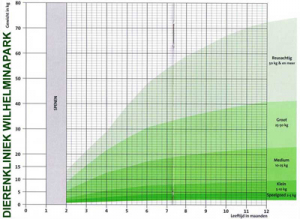How much Ready-made Fresh Meat (KVV) do you give to a dog?
( Last revision Jan 6, 2021 , written by IC Koutzarov and Ingrid Smolders)
Do you still have questions after reading this article? Feel free to ask them viavoedingadvies@bigdog.nl
Introduction
You have decided to feed Ready-Made Fresh Meat (KVV), partly or completely. But the question is, how much KVV should you give and how often? This article addresses these questions.
Life stage of the dog
The amount of CDV depends on, among other things, the phase of life your dog is in. A 9-week-old puppy eats up to 2.5 x the amount of an adult dog. He needs this amount, just like an adult dog, to meet his basic needs at rest: breathing, brain function, heart function, digestion, etc. and for playing, running, and other activities. But a puppy also needs more food than an adult dog for... growth!
Other factors that influence the amount of CDV include the size of the breed: A smaller dog has a higher metabolism (burning) than a large dog and a small dog therefore needs relatively more CDV than a larger dog. Other factors that also influence the condition are whether they have been spayed/neutered or not, how active they are, breed, and age.
Difficult? No, that's not too bad!
- In general, the guideline for the amount of CDV for adult dogs is 2% of the (desired) body weight per day.
| An example:
· My dog is two years old, weighs 25kg and is in good shape. Then he gets 2% x 25kg = 500gr per day. Mnemonic: 2×25=50+0 behind=500gr |
- Smaller dogs, up to approximately 5 kg, are allowed up to 2.5% of the (desired) body weight per day.
| An example:
· My dog is two years old, weighs 3kg and is in good shape. Then he gets 2.5% of 3kg = 75 grams per day |
- Neutered dogs should be allowed up to +/- 1.8% of the desired body weight per day.
| An example:
· My dog is two years old, weighs 25kg, has been neutered and is in good weight. Then he gets 1.8% of 25 kg = 450 grams per day |
Feed with your eye (and also with the scale)
Not every dog is the same, just like we humans are not all the same. One eats a whipped cream cake effortlessly without gaining weight and the other gets fat just by looking at it.
So, our advice, feed with your eye and your mind . If your dog is getting fatter, feed less. Is he getting thinner? Then feed some more. If you have walked less in recent days, give less.
And you're not sure? Then use the scale. You can walk in to almost any vet to weigh your dog.
And what about puppies?
It's a bit more complicated here, because you have to take into account, right!, the growth. On the one hand, the puppy is getting heavier and needs more food, but on the other hand, it is getting older and (relatively speaking) gets less food.
But luckily there are also guidelines for puppies!
Guidelines for the puppies
Fig. 1 Source: Wilhelminapark Veterinary Clinic
From figure 1 you can deduce that a large dog grows much faster than a small dog. You can also deduce that the ''big growth'' happens for all dogs between 0 and 7 months. After 7 months, the large breeds continue to grow, but not as fast. You can see this in the line of the graph, which no longer goes up as steeply. This is also a time when you give (relatively) less food.
Below is an overview of the amount of CDV and the number of feedings per day.
2-4 Months
A puppy of 2-4 months can have 5-6% of its own body weight if they are at a good weight, divided over 4 feedings per day.
4-7 months
A puppy aged 4-7 months may have 4-4.5% of its own body weight if they are at a good weight, divided over 3 feedings per day.
7-10 months
A puppy aged 7-10 months may have 3-3.5% of its own body weight if they are at a good weight, divided into 2 feedings per day.
10+ months
A 'puppy' of 10+ months may have 2-2.7% of its own body weight.
| Age/weight | 2-4 months 5-6% | 4-7 months 4-4.5% | 7-10 months 3-3.5% | 10+ months 2-2.7% |
| 2 | 100-120 gr | 80-90 gr | 60-70 gr | 40-57 grams |
| 3 | 150-180 gr | 120-135 gr | 90-105 gr | 60-81 grams |
| 4 | 200-240 gr | 160-180 gr | 120-140 gr | 80-108 gr |
| 5 | 250-300 gr | 200-225 gr | 150-175 gr | 100-135 gr |
| 7 | 350-420 gr | 280-315 gr | 210-245 gr | 140-189 grams |
| 10 | 500-600gr | 400-450 gr | 300-350 gr | 200-270 gr |
Fig 2
It is important to weigh your puppy weekly, especially until 7-8 months of age. For example, medium-sized breeds gain a kilo per week, so their diet needs to be adjusted!
Do you want to order immediately? Go to our webshop and we will be happy to prepare your order for you!


